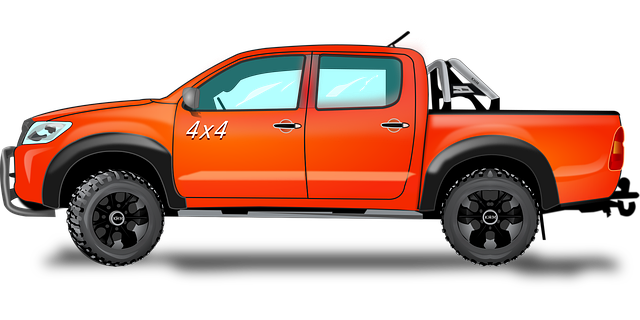Off-road vehicles require specialized recovery gear for safe and effective repairs in remote areas (RGVs). Essential tools like winches, straps, and diagnostic tools cater to unique challenges of RGV terrain. Robust repair kits, training workshops, and regular maintenance prolong equipment lifespan, ensuring 4×4 enthusiasts receive prompt service during breakdowns. Investing in 4×4-repair-rgv gear enhances road safety, reduces downtime, and supports reliable transportation across challenging landscapes.
In the rugged landscapes of rural and remote areas (RGV), reliable 4×4 vehicles are essential. However, navigating these terrains often demands specialized repair tools for efficient 4×4 maintenance. This article delves into the critical role of recovery equipment in 4×4 repairs, exploring specific tools tailored to RGV conditions. We’ll discuss common challenges and provide solutions, along with expert tips for maintaining your gear to ensure longevity. Key terms like ‘4×4-repair-rgv’ highlight essential aspects for off-road enthusiasts.
- Understanding Recovery Equipment: Essential Tools for 4×4 Repair
- The Role of 4×4-Specific Tools in RGV (Rural and Remote Areas)
- Common Challenges Faced During 4×4 Repairs and Suitable Solutions
- Maintenance Tips for Longevity: Ensuring Your Recovery Equipment Lasts
Understanding Recovery Equipment: Essential Tools for 4×4 Repair

Recovery equipment, specifically designed for off-road vehicles like 4x4s, is an essential toolkit for any enthusiast or professional mechanic. These tools are tailored to navigate the unique challenges posed by rugged terrain and unexpected breakdowns. When a 4×4 finds itself stranded in the wilderness or facing complex repairs, having the right recovery gear can make all the difference between a frustrating obstacle and a manageable situation.
For instance, winches, a common element in 4×4-repair RGV (recovery vehicle gear), offer immense pulling power to extract vehicles from muddy boggs or steep inclines. Additionally, recovery straps and tethers provide secure tie-downs, ensuring stability during towing or lifting operations. Understanding how to utilize these tools effectively is crucial for successful 4×4 repairs in remote locations, where professional assistance might be hours or even days away.
The Role of 4×4-Specific Tools in RGV (Rural and Remote Areas)

In rural and remote areas (RGV), where terrain can be challenging and infrastructure limited, 4×4 vehicles are often essential for navigation and transportation. However, their complex mechanisms and off-road capabilities also mean that specialized repair tools are necessary to effectively service these vehicles. 4×4-specific tools designed for rugged environments play a pivotal role in ensuring timely and efficient vehicle recovery and maintenance in RGVs. These tools cater to the unique demands of 4×4 repairs, allowing mechanics to access and address issues that might be inaccessible in more urban settings.
When it comes to 4×4-repair-rgv, specialized equipment such as powerful jack systems, off-road recovery winches, and specialized diagnostic tools are invaluable. These tools enable technicians to handle the demanding nature of rural terrain, from navigating loose gravel and rocky paths to addressing complex mechanical failures. By investing in robust 4×4 repair tools tailored for RGV conditions, local communities can enhance road safety, reduce vehicle downtime, and ensure reliable transportation across challenging landscapes.
Common Challenges Faced During 4×4 Repairs and Suitable Solutions

The world of 4×4 repairs presents unique challenges, particularly in regions like the RGV (Rio Grande Valley) where terrain and environmental conditions can be demanding. One common hurdle is accessing hard-to-reach components, especially on vehicles designed for rugged off-road use. This often requires specialized tools and techniques to navigate tight spaces without causing further damage.
Suitable solutions involve investing in versatile repair kits tailored for 4x4s, including diagnostic equipment to identify issues quickly. Additionally, training workshops focused on RGV-specific challenges can empower local mechanics with the skills needed to handle complex repairs efficiently. This ensures that when 4×4 enthusiasts encounter breakdowns, they have access to knowledgeable professionals equipped to address these unique problems swiftly, keeping their vehicles on the road and ready for the next adventure.
Maintenance Tips for Longevity: Ensuring Your Recovery Equipment Lasts

To ensure your recovery equipment lasts, proper maintenance is key, especially for rugged 4×4-repair-rgv vehicles that face diverse terrains. Regular checks and servicing can significantly extend the lifespan of critical components like winches, recovery straps, and jack systems. Start with a routine inspection to identify any signs of wear or damage; this proactive approach can prevent costly breakdowns during urgent situations.
Follow a structured maintenance schedule, which includes lubricating moving parts, inspecting cables and belts for fraying or cracks, and tightening connections securely. Cleaning equipment after each use, particularly in dusty environments, prevents debris buildup that could lead to mechanical failures. Always refer to the manufacturer’s guidelines for specific care instructions tailored to your recovery gear.
In conclusion, recovery equipment is an indispensable asset for efficient 4×4 repairs, especially in rural and remote areas (RGV). By understanding the specific tools required and implementing effective maintenance practices, off-road enthusiasts can navigate challenges with ease. These strategies not only ensure prompt troubleshooting but also prolong the lifespan of crucial components, making every 4×4 repair a seamless and successful experience for those venturing into RGV terrains.
